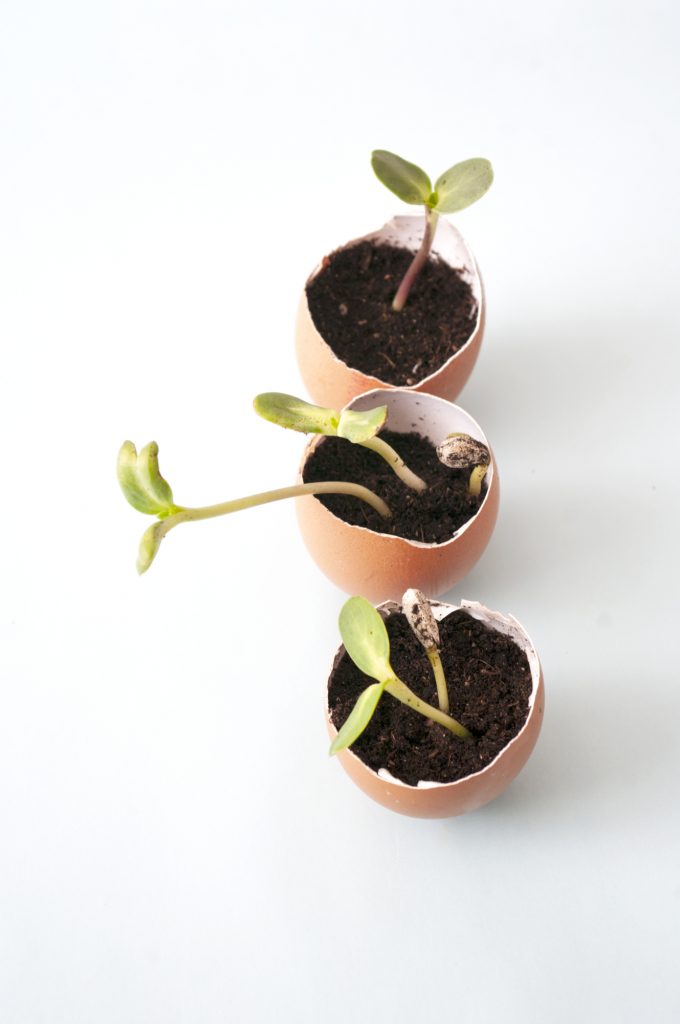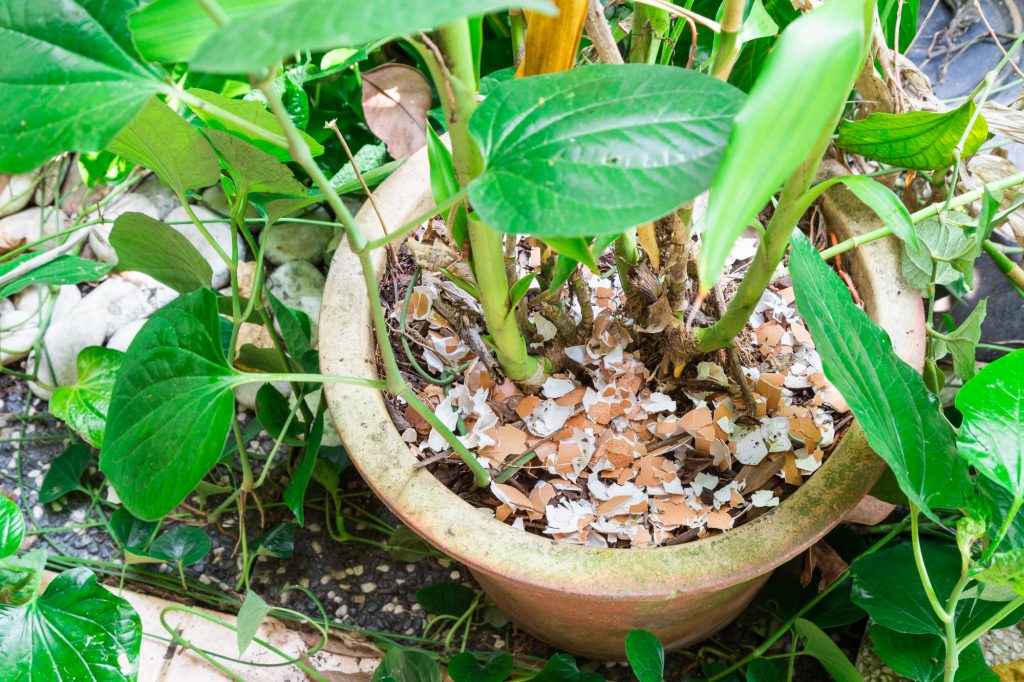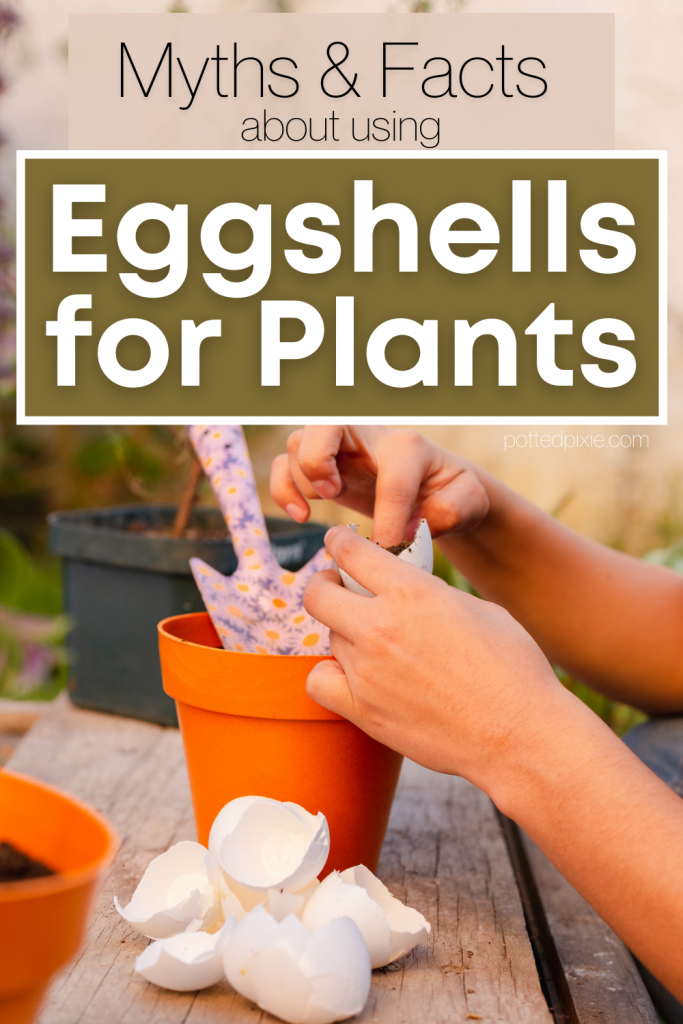Is adding eggshells in houseplants an old wives tale, or do they actually provide some benefit to your potted plants? Whether you’ve been doing this for years because your Grandmother did or because it’s become a popular subject among plant parents again, let’s dive into the myths and facts about adding eggshells to your plants.
Generally speaking, crushed eggshells are good for houseplants as long as you don’t view them as the “be-all end-all” miracle treatment. To enjoy the benefits of eggshells in your indoor garden, they must be properly prepared and used in conjunction with the rest of your regular maintenance. As an added bonus, you can use them as a zero-waste way to start your vegetable garden seeds!

This post contains affiliate links, which means I may make a small commission if you click through and make a purchase.
Are Eggshells Good for Houseplants?
Eggshells are good for providing an added calcium boost to your plants, but that’s as far as the benefits go. Still, it’s an impressive method to help your plants thrive.
For instance, If you have a plant that hasn’t been repotted for several years, you’ll notice that it becomes a little more lively after being on the receiving end of eggshell-derived calcium.
As a beneficial nutrient, calcium has several ways it can help potted plants. It can help balance out the acidity of soil which will help it absorb water more efficiently. It’s also believed that calcium helps roots grow in the way that they’re intended to without becoming deformed.
If you’re noticing leaves misshaping as they grow, the added calcium from eggshells can help correct that.
Best of all, if you eat eggs anyway, eggshells are a totally free way to help keep your plants healthy.
It’s a myth that eggshells deter slugs and other pests, and anyone who tells you otherwise is probably doing something else right to keep critters away.

How Do You Prepare Eggshells for Plants?
There are a few ways you can use eggshells to feed your plants. No matter what method you use, you must clean and dry your eggshells before using them.
Clean and Dry the Eggshells
First, rinse the eggshells with water until there is no egg protein left. Then they need to be dried. You can either leave them out in a sunny spot for a day or two, or bake them in the oven (about 200 degrees for 10 minutes).
Drying your eggshells is very important so that you don’t introduce added moisture to your indoor plants. This can attract pests and mold. It also helps get rid of added smells so that your pets stay away from them too.
You’ll know the eggshells are properly dried when they become hard and almost feel like glass when you lightly tap them against a plate or a bowl.
Make Eggshell Tea
My favorite method for using eggshells in houseplants is to make an ‘eggshell tea.’ It’s the perfect organic plant food.
Place the dried eggshells in a food processor or crush them up using a mortar and pestle. Then, boil them in water for about 5 minutes and let the water cool. I like to add a little apple cider vinegar to help pull out the calcium.

Allow the crushed eggshells to steep in this water for 1-2 days. Place the eggshell water in a container with a lid and leave it at room temperature. Then strain out the pieces and use the calcium-enriched water for your plants.
If you want to step it up a notch, add half a teaspoon of epsom salts and some fish emulsion and you’ve got yourself some homemade eggshell fertilizer.
Grind Them into a Fine Powder
You can also just sprinkle straight eggshells into the soil of your houseplants. Make sure they’re ground into a fine powder. You can use a food processor or a coffee grinder for the best results.
Then sprinkle them on the soil and mix it in about 1-2 inches deep.
If you don’t have a food processor or grinder, you can place the eggshells in a ziploc bag and use a heavy rolling pin to crush them into tiny pieces.
Using Eggshells to Start Seeds
If you want a cheap and effective way to start your seeds, you can use empty egg shells. Make sure a little more than half the shell is in tact.
Wash and dry the same way as above, then fill with dirt and plant your seeds.
You can keep them in the egg carton, provided there’s a tray or cloth underneath to catch any excess water that seeps through.
When you’re ready to plant your seedlings into the ground, lightly crack the eggshell and plant it directly in the soil.
You need to make sure the eggshell is broken when you plant the seedling so that the roots can grow and don’t become stunted.

How Long Will it Take for My Plant to Absorb Calcium from the Eggshells?
It can take up to a year for the calcium to start to become absorbed into the soil, so it’s definitely a slow release!
But the more fine the powder, the faster it can work itself into the soil. Since it takes a while for the eggshells to break down and for the plant to absorb the calcium, you should only use eggshells in your plants no more than once per year.
That’s why eggshell water is usually the best way to introduce organic calcium into your potted plants.
As far as how much crushed eggshells to sprinkle on your plants – it all depends on how much you have.
For large houseplants or one tomato plant, for example, I recommend sprinkling about a handful. Less is also fine if you don’t have that much.
Since the calcium releases so slowly, you really can’t overdo it either, so don’t stress too much over the amount.

What Plants do Well With Eggshells?
Indoor Plants
Calcium loving indoor plants include: orchids, african violet, kalanchoe, hoyas, spider plants and ivy plants. You can also use eggshells for succulents.
If you’re going to give your indoor plants an extra calcium boost through eggshells, I recommend the eggshell tea method described above.
You can even add the eggshell water to a spray bottle and use it to fertilizer your orchids (especially if you want to help bring them back to life).
Vegetable Plants
Tomatoes are the best plants that do well with eggshells. The added calcium helps prevent blossom end rot by helping the plant regulate its water intake.
It’s also believed that an adequate amount of calcium helps boost the flavor of the tomato fruit. and you can use quite a bit of crushed eggshells in your tomato plants.
I suggest sprinkling eggshell powder directly in the soil before you plant and then on the surface of the soil every few weeks.
Cucumbers will be crispier with extra calcium from eggshells!
Why do Plants Need Calcium?
Now that we understand that eggshells are beneficial for houseplants because they help add calcium to the soil, it’s important to understand what calcium does for plants.
The biggest benefit for plants is that calcium helps with cell structure development. Stronger cells keep a plant healthier and more stable as it grows. and more resistant to pathogens, pests and poor living conditions. Just like humans need calcium for a strong foundation, so do plants!
Stay Green!


Great info! Thanks!